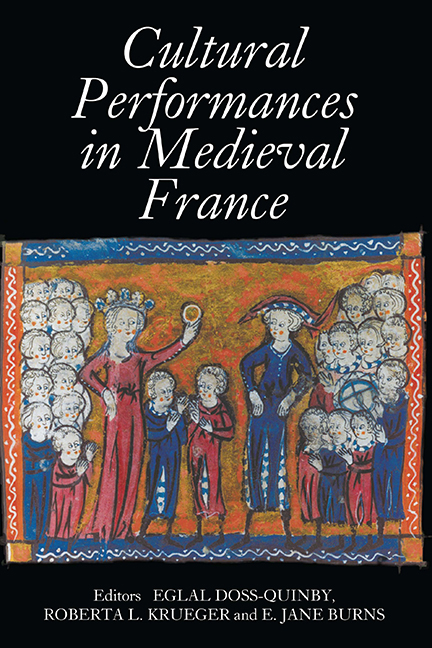Book contents
- Frontmatter
- Contents
- List of Illustrations
- Contributors
- Introduction
- Nancy Freeman Regalado, Curriculum Vitae
- PART I POETIC AND MUSICAL PERFORMANCES
- PART II PERFORMING SEXUAL AND SOCIAL IDENTITIES
- PART III DEVOTIONAL PRACTICE AND TEXTUAL PERFORMANCE
- PART IV PERSUASIVE PERFORMANCES
- Dramatic Troubles of Ecclesia: Gendered Performances of the Divided Church
- Preaching the Sins of the Ladies: Nicole Bozon's “Char d'Orgueil”
- Making Names, Breaking Lives: Women and Injurious Language at the Court of Isabeau of Bavaria and Charles VI
- Performing the Nation: The Play Performed at the Great Feast in Christine de Pizan's Biography of Charles V
- PART V RE–ENACTMENTS AND LEGACIES
- Tabula Gratulatoria
- Tabula Gratulatoria
Making Names, Breaking Lives: Women and Injurious Language at the Court of Isabeau of Bavaria and Charles VI
from PART IV - PERSUASIVE PERFORMANCES
Published online by Cambridge University Press: 24 October 2017
- Frontmatter
- Contents
- List of Illustrations
- Contributors
- Introduction
- Nancy Freeman Regalado, Curriculum Vitae
- PART I POETIC AND MUSICAL PERFORMANCES
- PART II PERFORMING SEXUAL AND SOCIAL IDENTITIES
- PART III DEVOTIONAL PRACTICE AND TEXTUAL PERFORMANCE
- PART IV PERSUASIVE PERFORMANCES
- Dramatic Troubles of Ecclesia: Gendered Performances of the Divided Church
- Preaching the Sins of the Ladies: Nicole Bozon's “Char d'Orgueil”
- Making Names, Breaking Lives: Women and Injurious Language at the Court of Isabeau of Bavaria and Charles VI
- Performing the Nation: The Play Performed at the Great Feast in Christine de Pizan's Biography of Charles V
- PART V RE–ENACTMENTS AND LEGACIES
- Tabula Gratulatoria
- Tabula Gratulatoria
Summary
In the murky climate of Paris 1413, on a Mayday when king Charles VI had gone mad, noble factions were killing each other off, and the city in revolt, the major chroniclers focused on one episode. Each narrated the arrest of women attending the queen, Isabeau of Bavaria. Jean Le Fèvre's account presents a menacing break-in (75–79). A crowd of commoners, led by butchers known as the Cabochiens, penetrated the Hôtel particulier of the dauphin demanding that he hand over all traitors in his residence. Next stop: the queen's own Hôtel Saint-Pol where a roll-call of traitors was read out loud in front of Isabeau. Six dames and four damoiselles d'honneur were named and denounced as traitors. Deep into the queen's private chambers, the women were pursued until with much “fear and weeping,” they were led away to prison. The Bourgeois of Paris's version of the damoiselles’ arrest, by contrast, is summed up in a few judgmental lines: thirteen or fourteen of them were taken away for “they were well familiar with evil doing.”
No chronicle mentions these women again. The silence is telling. It suggests how precarious was their social role, how fragile their reputation. It is symptomatic of infamy: the complete loss of name in the public domain. It was as if the damoiselles no longer existed socially speaking, as if they were dead. That infamous disappearing from the record prompted historian Colette Beaune to surmise that once they were imprisoned, they were “badly mistreated, raped.”
Whether this group of women was guilty of any crime is a moot point. These chronicles and their representations were caught in the crossfire of partisan politics in a city riven by civil war and under constant threat of invasion. Were the damoiselles charged and attacked as part of the royal entourage? As members of this or that noble faction? As intimates of one of the most pilloried queens of France, besieged by charges of infidelity and corruption? In such a polarized context, hypotheses about them proliferated. And they prove very difficult to substantiate. Yet one point remains clear: the damoiselles of Isabeau had borne the brunt of repeated verbal attacks. They were hit by accusations from all political sides, represented negatively by preachers, royal propagandists, nobles, and people in the city streets. Systematically the women were stigmatized as disruptive, conniving, malicious, and publicly dangerous.
- Type
- Chapter
- Information
- Cultural Performances in Medieval FranceEssays in Honor of Nancy Freeman Regalado, pp. 203 - 218Publisher: Boydell & BrewerPrint publication year: 2007



